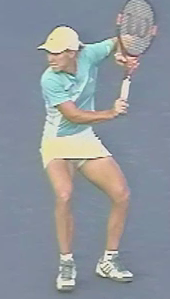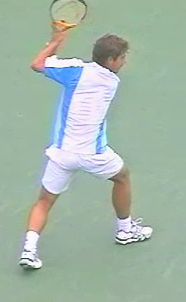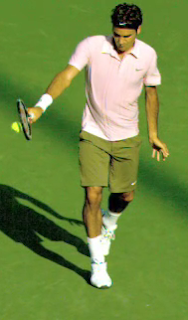Brett's Backhands Review:
These are your Backhands Brett. Let's see how we can understand your stroke while compare it to what the pros do.
The first thing you do is the grip change. As you can see on the picture you change the grip in front of the body with the racquet low and horizontal and the right arm fully stretched.
Up to here all is fine. Justine Henin used to have the racquet in a similar position while changing the grip. However, Justine's grip is stronger than yours. You should rotate your right hand knucles around to your left. Compare with Justine's pic 1 below.
After the grip change, the critical element to have a consistent Backhand is the Unit turn. The Unit turn as the name suggests, is the turn of the whole body as a single unit. The shoulders, hands and racquet should start turning or rotating at the same speed.
Notice how during these three pictures, while your right hand has only gone back a tiny bit, your left hand is already half way in line with your chest. Therefore we can say that your left hand is moving faster than your right hand. You can see below on picture 4, your elbow is still tucked close to your left torso.
You have positioned the racquet very horizontally with the tip of the racquet to the back fence.
At the top of the Backswing your racquet is extremely horizontal. Your right hand is way too high, almost as high as the left hand. If you look at your next picture, apart from the grip you seem to be hitting a slice.
pic 5
Let's see how Justine Henin does it:
Justine's racquet is already almost vertical. The right elbow is now quite separated from the torso, The dominant right hand is quite low, much lower than the left hand on the last picture. Justine is still loading here. Let's see her position at the end of the backswing:
As you can see, the racquet is now positioned completely vertical. She is ready to step into the incoming ball with her right foot. From the start of these 4 pictures, Justine has raised up both hands, and specially the left hand. Have a look how Justine's left shoulder is extremely higher than her right shoulder. Another crucial element is her left elbow far away from the body. Check pic 3 and 4 from Justine.
Compared with your Picture 5 Brett, her racquet is not too far back towards the back fence like yours.
pic 6
So we can say that at the end of the backswing up until the ball bounces and we are ready to step into the ball, our racquet should be vertical with some tilt of the shoulders, right hand underneath the left hand and racquet not too far back towards the back fence.
Watching Federer's picture we can see how close to the head is his racquet head. His racquet is totally vertical, even further than vertical, tilting slightly forwards!
Let's see what happens after
pic 7
pic 8
As you prepare to step to the ball, your hands start getting lower, your racquet is still almost horizontal. You're going forward with an amazing right foot step! I hope you can make contact right in front and not getting late!!
Let's see what Federer the maestro does while he is stepping into the ball:
Looking at these last pictures we can understand how amazingly simple Federer's backhand is. His racquet hasn't really moved from the first to the third picture. All he seems to do is continue his rotation of the shoulders with the minimum movement of the racuet and hands. The next picture we can see Federer on a much bigger step:
As we can see on the previous picture, Federer still maintains his racquet vertical as he steps in. Even on a stretching shot. His racquet head will only start dropping after he has transfered his weight to his front foot.
Going back to Brett, let's see what happens next as his left hand goes off the racquet.:
pic 10
Although is the picture is quite small, we can still see that the grip could be a bit stronger. Notice how the racquet is already perpendicular to the net and his right hand is too far back. If you go back to Pic 9 Brett, you have the closest position to the trigger. You've reached that one pic 9 way before you stepped in. If you were playing closer to the back fence your racquet would certainly hit it. Federer would be able to play extremely close to the back fence without his racquet touching the fence at all.
Lets see how Fed does it after:
The last picture, Federer has his racquet perpendicular to the net. Compare this picture to your picture 10 Brett. Because his hand is so much more in front than yours, it is much easier for Federer to have a consistent contact. He could have been very close to the back fence that he wouldn't touch it with his backswing and forward swing.
Lets conpare both of your contacts:
pic 11
Federer's now:
The next video is probably your best video from the side view:
As we look at it now, we have a better idea of what you do Brett. After the grip change you start moving your racquet backwards, elevating the right hand and keeping the racquet horizontally. We already saw how you can improve your grip and try keeping your racquet vertical at the end of the backswing. Your hands seem to move back too fast, so your unit turn can be improved! There is no rush to take the racquet back!
On this shot I really like that first step back with your left foot to give you the rotation and the time to step forward to the ball.
Although your racquet head is still above your right hand on this trigger position, this is a better position than picture 9. The racquet is not parallel to the baseline but its not too far. A stronger grip would definitely help!
The contact is right in front and follow through ok with a good extension although you finish a bit open.
These are the analysis for now Brett!
Got some pointers to work on:
Grip, Unit Turn, racquet vertical, trigger...
Good luck!
































Great analysis Andre!
ReplyDelete